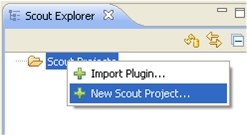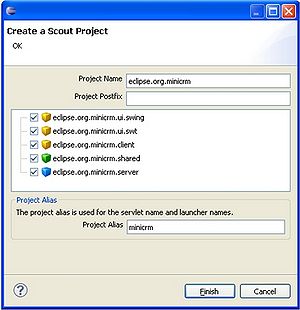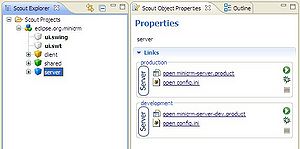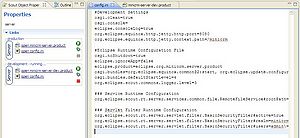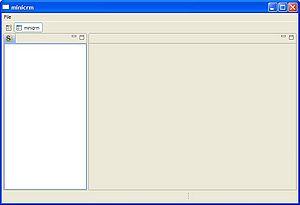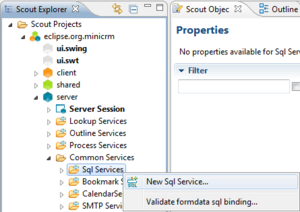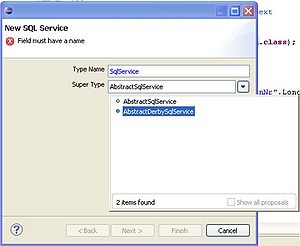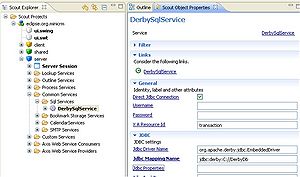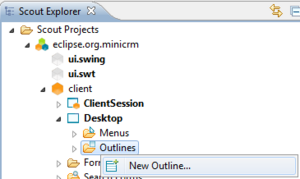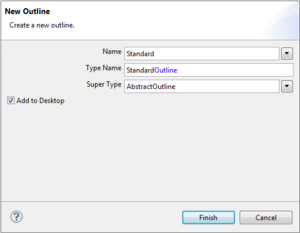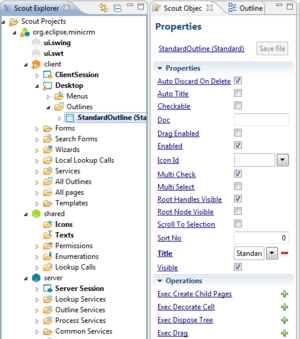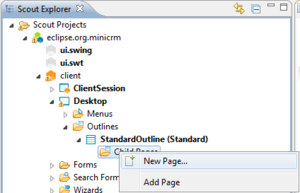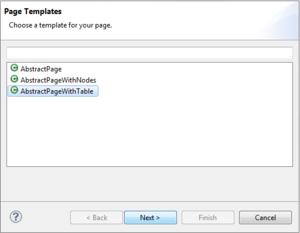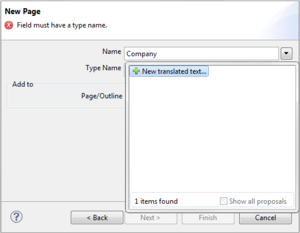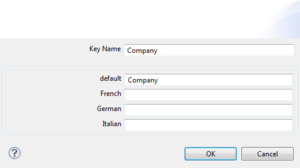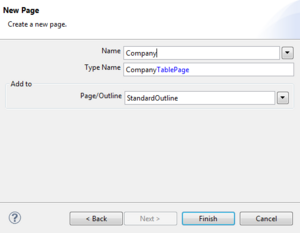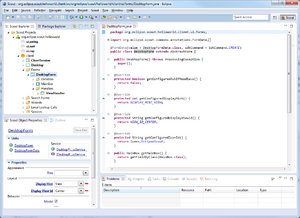Notice: this Wiki will be going read only early in 2024 and edits will no longer be possible. Please see: https://gitlab.eclipse.org/eclipsefdn/helpdesk/-/wikis/Wiki-shutdown-plan for the plan.
Difference between revisions of "Scout/Tutorial/3.7/Minicrm Step-by-Step"
| Line 19: | Line 19: | ||
== Create an Outline == | == Create an Outline == | ||
| − | # New Outline | + | # Now first we would like to have a page in our minicrm which lists the companies of the Company table. Before you can add pages to your application you need to define an ''Outline'' first. Therefore open the client node in Eclipse Scout and expand the tree until you get to the ''Desktop'' node. Do a right click on that node and choose ''New Outline...''.<br/>[[Image:Newoutline.jpg|thumb|left]]<br/><br clear="all" />As name choose ''Standard'' and make sure the checkbox ''Add to Desktop'' is ticked. Then click finish.<br/>[[Image:Newoutlinewizard.jpg|thumb|left]]<br clear="all" />When you expand the ''Desktop'' furthermore now, you should see the ''StandarOutline'' below it.<br/>[[Image:Standardoutline.jpg|thumb|left]]<br clear="all" /> |
| − | # New Table | + | # Now you can add a new page to your StandardOutline. Right click on the ''Child Pages'' node of your ''StandardOutline'' and then choose ''New Page...''.<br/>[[Image:Newpage.jpg|thumb|left]]<br clear="all" />From the dropdown list choose ''AbstractPageWithTable'' then click next.<br/>[[Image:Newtablepage.jpg|thumb|left]]<br clear="all" />Now enter the name for the page which in our case is ''Company''. If this label text is missing, there will appear a contextmenu ''New translated text...'' in the ''Name'' field. If this is the case, enter there the data for the new translated text and click ok.<br/>[[Image:Newtext.jpg|thumb|left]]<br clear="all" /><br/>[[Image:Companytext.jpg|thumb|left]]<br clear="all" />This will create an entry in the files ''Texts.java'' and the to the language corresponding properties file (e.g. ''Texts.properties'' for the default language, ''Texts_de.properties'' for German, and so on).<br/>[[Image:Nls.jpg|thumb|left|If you expand the ''shared'' node in your Eclipse Scout project, activate ''Texts'' and click on ''open nls editor'' in the Scout Object properties view, you can manage all your application's texts.]]<br clear="all" /><br/>Now you can click finish, this will create your ''CompanyTablePage''.<br/>[[Image:Companytablepage.jpg|thumb|left]]<br clear="all" />When you expand now the ''Child Pages'' folder below your ''StandardOutline'', you'll find your ''CompanyTablePage''. When you expand the node ''Table'', you'll find a folder ''Menus'' and ''Columns''. Below ''Columns'' we will now add the columns that are needed to display the company data.<br/>[[Image:Finishedcompanytablepage.jpg|thumb|left]]<br clear="all" /> |
# Add Columns | # Add Columns | ||
# getConfiguredDisplayable vs. getConfiguredVisible | # getConfiguredDisplayable vs. getConfiguredVisible | ||
| Line 59: | Line 59: | ||
# execLoad | # execLoad | ||
# Add variables | # Add variables | ||
| + | |||
| + | == Deployment == | ||
Revision as of 14:21, 25 March 2010
Contents
Prerequisites
- Have a look at the EclipseScout Client Component Model: Main Concepts
Installation / Set Up
Create a new EclipseScout project
- If you haven't done so yet, change to the Scout perspective. On the folder Scout Projects, right click and choose New Scout Project in order to create a new Scout project.
As project name, enter eclipse.org.minicrm. - Start Server: Click on the server node and start the development server product by clicking on the green arrow.
- Test Server: To test if the server is running properly, go to http://localhost:8080/minicrm/process. To log in, use admin as username and manager as password. There you should see a page with information about the server. The login information is defined in the config.ini file of the server product, click on open product and then change to the configuration tab in order to open it.
- Start Client: Click on either the ui.swing or the ui.swt node and start the development client product by clicking on the green arrow. When asked for a login, enter the same login information as before, admin/manager (or any other user/password pair from the config.ini). An empty application window should appear.
Add the SqlService
- Go to the server node and open the tree, drill down until Sql Services below Common Services and right click in order to open the wizard to create a new SQL service.
Name your new service DerbySqlService and choose AbstractDerbySqlService from the combobox Super Type then click finish. - Adjust the default settings in your DerbySqlService by editing the Jdbc Mapping Name, this should point to the folder where you unzipped the DerbyDb to.
Create an Outline
- Now first we would like to have a page in our minicrm which lists the companies of the Company table. Before you can add pages to your application you need to define an Outline first. Therefore open the client node in Eclipse Scout and expand the tree until you get to the Desktop node. Do a right click on that node and choose New Outline....
As name choose Standard and make sure the checkbox Add to Desktop is ticked. Then click finish.
When you expand the Desktop furthermore now, you should see the StandarOutline below it. - Now you can add a new page to your StandardOutline. Right click on the Child Pages node of your StandardOutline and then choose New Page....
From the dropdown list choose AbstractPageWithTable then click next.
Now enter the name for the page which in our case is Company. If this label text is missing, there will appear a contextmenu New translated text... in the Name field. If this is the case, enter there the data for the new translated text and click ok.
This will create an entry in the files Texts.java and the to the language corresponding properties file (e.g. Texts.properties for the default language, Texts_de.properties for German, and so on).
Now you can click finish, this will create your CompanyTablePage.
When you expand now the Child Pages folder below your StandardOutline, you'll find your CompanyTablePage. When you expand the node Table, you'll find a folder Menus and Columns. Below Columns we will now add the columns that are needed to display the company data. - Add Columns
- getConfiguredDisplayable vs. getConfiguredVisible
- The DB tables:

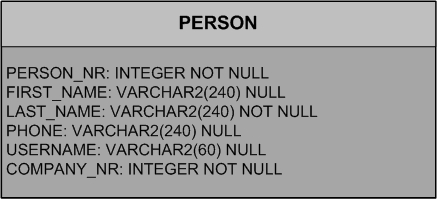
- Get Data for Table
- BindBases
Create a Form
- New Form
- FormHandler
- ProcessService
- FormData
- SQL.selectInto
Start the Form
- New Menu
- execAction
Modify the Form
- Validation
- Formatting
- Changing Background or Foreground
Extend the Form
- Smartfield
- HtmlField
- Button
Create a SearchForm
Expand the Tree
- NodePage
Bing Webservice
- Scope
- execLoad
- Add variables

